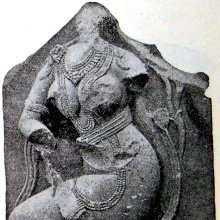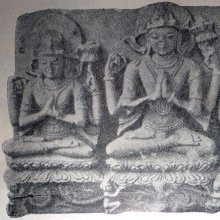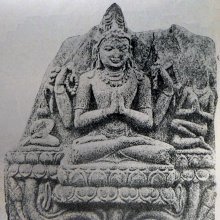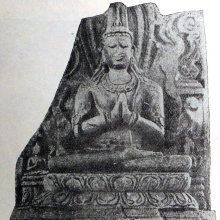Virasana, Vira-asana, Vīrāsana: 27 definitions
Introduction:
Virasana means something in Hinduism, Sanskrit, Jainism, Prakrit, Marathi, Hindi. If you want to know the exact meaning, history, etymology or English translation of this term then check out the descriptions on this page. Add your comment or reference to a book if you want to contribute to this summary article.
Alternative spellings of this word include Virasan.
Images (photo gallery)
In Hinduism
Shilpashastra (iconography)
Source: Google Books: The Book of Hindu Imagery: Gods, Manifestations and Their MeaningVirasana (Vira-asana)—This “heroic position” is found in several different forms. One of these is hardly any different from the padmasana. The legs are placed on top of each other instead of being intertwined. In many cases just one leg lies curved on the pedestal, while the other hangs down to the ground. This position represents a god who has revealed himself to be a hero in the battle against the demons.
Source: Google Books: Elements of Hindu iconographyThe Vīrāsana (वीरासन) requires the left foot to rest upon the right thigh and the left thigh upon the right foot.
Source: Shodhganga: The significance of the mūla-beras (śilpa)Vīrāsana (वीरासन) refers to a type of Āsana (sitting poses), according to Ganapati Sthapati in his text Ciṟpa Cennūl, as defined according to texts dealing with śilpa (arts and crafs), known as śilpaśāstras.—When one leg is hung down and placed on the ground with the other leg bent, with the foot resting on its thigh, and the body is held erect in an aggressive manner, the whole figure denoted a regal bearing. This is called vīrāsana or heroic pose. Vyākhyāna Dakṣināmūrti is a suitable example of the posture.

Shilpashastra (शिल्पशास्त्र, śilpaśāstra) represents the ancient Indian science (shastra) of creative arts (shilpa) such as sculpture, iconography and painting. Closely related to Vastushastra (architecture), they often share the same literature.
Dharmashastra (religious law)
Source: Google Books: Manusmṛti with the ManubhāṣyaVīrāsana (वीरासन) When one rests, neither on a raised platform nor on a bedstead, but simply by sitting down, it is called the Vīrāsana posture. (See the Manubhāṣya verse 11.110)

Dharmashastra (धर्मशास्त्र, dharmaśāstra) contains the instructions (shastra) regarding religious conduct of livelihood (dharma), ceremonies, jurisprudence (study of law) and more. It is categorized as smriti, an important and authoritative selection of books dealing with the Hindu lifestyle.
Yoga (school of philosophy)
Source: Wisdom Library: YogaVīrāsana (वीरासन) is one of the eighty-four āsanas (postures) taught by Śiva, according to the Haṭharatnāvalī 3.7-20. It is said that Ādinātha (Śiva) hand-picked 84 yoga postures from 84,00,000 living beings and taught them for the purpose of introducing physical health and well-being to the human body. The compound vīrāsana translates to vīra (hero) and āsana (posture).
The 17th-century Haṭharatnāvalī is a Sanskrit reference book dealing with these āsanas (e.g., vīrāsana) which form a major constituent of the haṭhayoga practice. It was written by Śrīnivāsa.
Source: Google Books: The Hatha Yoga PradipikaVīrāsana (वीरासन) is the name of an āsana (posture), according to Haṭhayogapradīpikā I.23.—Accordingly, “One foot is to be placed on the thigh of the opposite side; and so also the other foot on the opposite thigh. This is called vīrāsana”.
The 15th-century Haṭhayogapradīpikā by Svātmārāma is one of the oldest extant texts dealing with haṭhayoga: an ancient form of meditation founded by Matsyendranātha. The first chapter of this book describes various āsanas (e.g., vīra-āsana)
Source: archive.org: Yoga Tradition of the Mysore PalaceVīrāsana (वीरासन) is a type of standing posture (āsana), according to verse 78 of the Śrītattvanidhi.—Accordingly, “Place one foot on the thigh and the other foot on the other thigh.This is vīrāsana, the āsana of the hero”.
The 19th-century Śrītattvanidhi is a sanskrit treatise describing 80 primary āsanas, or ‘posture’ (e.g., vīra-āsana) and several additional ones.
See notes on vajrāsana.
Source: archive.org: Gheranda SamhitaVīrasana (वीरसन) is one of the thirty-two āsanas (postures) taught in the second chapter of the Gheraṇḍasaṃhitā: “Placing one foot on the other thigh and the other foot under the other thigh is called Vīrasana”.
Vīrasana is one of the selected 32 postures amongs 8,400,000 total mentioned by Śiva, according to Gheraṇḍasaṃhitā 2.1-2, “In all, there are as many Āsanas as species of animals. Eighty-four lacs of them are mentioned by Śiva. Out of them, 84 are regarded as important and among these 84, again 32 are good (enough) in this world of mortal beings”.
The 17th-century Gheraṇḍasaṃhitā (mentioning vīra-āsana) is one of the three classic texts of Haṭha-yoga: a major branch of Yoga, sharing similarities with the Yoga system taught by Patañjali, though claiming its own mythical founder known as Matsyendranātha. This gheraṇḍa-saṃhitā is an encyclopedic Sanskrit treatise describing thirty two such āsanas.

Yoga is originally considered a branch of Hindu philosophy (astika), but both ancient and modern Yoga combine the physical, mental and spiritual. Yoga teaches various physical techniques also known as āsanas (postures), used for various purposes (eg., meditation, contemplation, relaxation).
Purana and Itihasa (epic history)
Source: archive.org: Shiva Purana - English TranslationVīrāsana (वीरासन) also called paryaṅka-bandha. It is a particular kind of posture practised by ascetics in meditation setting on the hams.
Source: Cologne Digital Sanskrit Dictionaries: The Purana IndexVīrāsana (वीरासन).—The posture in which Pṛṣadhra sat and protected the cattle of his preceptor during nights.*
- * Bhāgavata-purāṇa IX. 2. 3.

The Purana (पुराण, purāṇas) refers to Sanskrit literature preserving ancient India’s vast cultural history, including historical legends, religious ceremonies, various arts and sciences. The eighteen mahapuranas total over 400,000 shlokas (metrical couplets) and date to at least several centuries BCE.
Shaktism (Shakta philosophy)
Source: academia.edu: The Śāradātilakatantra on YogaVīrāsana (वीरासन) refers to one of the five āsanas (postures) explained by Lakṣmaṇadeśika in his 11th-century Śaradātilaka verse 25.15cd-16ab.—“Having put one foot below and having placed the other one on the thigh, the Yogin should sit with erect body; thus the heroic posture (vīrāsana) is described”.

Shakta (शाक्त, śākta) or Shaktism (śāktism) represents a tradition of Hinduism where the Goddess (Devi) is revered and worshipped. Shakta literature includes a range of scriptures, including various Agamas and Tantras, although its roots may be traced back to the Vedas.
Pancaratra (worship of Nārāyaṇa)
Source: archive.org: Catalogue of Pancaratra Agama TextsVīrāsana (वीरासन) refers to one of the Mudrās mentioned in the eighteenth chapter of the Agastyasaṃhitā (agastya-suīkṣṇa-saṃvāda edition), an ancient Pāñcarātra Āgama text dealing with the worship of Rāma, Sītā, Lakṣmaṇa and Hanumān.—[Cf. the chapter pūjāsādhanalakṣaṇa].—[...] One should offer pūjā with devotion [bhakti] and orderliness [saṃkalpa]. [...] Postures [āsana] to be assumed during worship are then discussed—with descriptions of the following: [e.g., vīrāsana]. There are many others, the text adds, any one of which can be selected for the repetition of God’s names and for other pious activities [japādi].

Pancaratra (पाञ्चरात्र, pāñcarātra) represents a tradition of Hinduism where Narayana is revered and worshipped. Closeley related to Vaishnavism, the Pancaratra literature includes various Agamas and tantras incorporating many Vaishnava philosophies.
In Jainism
General definition (in Jainism)
Source: archive.org: The Jaina IconographyVīrāsana (वीरासन) refers to one of the various āsanas (postures) commonly depcited in Jain iconography.—It is well-known that the Indian Yogīs practise the various Āsanas to gain some control of the body, proceeding as they do, towards the Rāja-yoga or higher mental culture.
Source: archive.org: TrisastisalakapurusacaritraVīrāsana (वीरासन) or simply Vīra is the name of a posture (āsana), according to chapter 2.1 [ajitanātha-caritra] of Hemacandra’s 11th century Triṣaṣṭiśalākāpuruṣacaritra: an ancient Sanskrit epic poem narrating the history and legends of sixty-three illustrious persons in Jainism.
Accordingly, “the elephant of kings (i.e., Vimalavāhana) dismounted from the elephant’s shoulder and entered the garden, like a lion a mountain-cave. [...] He saw monks there, too, some in the [viz., vīrāsana-posture, ...] some engaged in kāyotsarga, and some in ukṣa-posture, indifferent to the body, who had carried out their vows in the midst of numerous attacks, like soldiers in battles, victorious over internal enemies, enduring trials, powerful from penance and meditation [...] The King, with devotion sprouted in the guise of horripilation, as it were, approached Ācārya Arindama and paid homage to him”.
Source: The University of Sydney: A study of the Twelve ReflectionsVīrāsana (वीरासन) refers to the “hero posture”, according to the 11th century Jñānārṇava, a treatise on Jain Yoga in roughly 2200 Sanskrit verses composed by Śubhacandra.—Accordingly, “On a flat piece of wood or stone, on the ground or on sandy soil, the wise [person] should adopt a stable posture for the accomplishment of absorption. Thus, sitting cross-legged, sitting half cross-legged, thunderbolt, hero posture (vīrāsana—vajraṃ vīrāsanaṃ) and the previously mentioned pleasant and lotus [postures] as well as abandonment of the body is highly thought of. [...]”.

Jainism is an Indian religion of Dharma whose doctrine revolves around harmlessness (ahimsa) towards every living being. The two major branches (Digambara and Svetambara) of Jainism stimulate self-control (or, shramana, ‘self-reliance’) and spiritual development through a path of peace for the soul to progess to the ultimate goal.
Languages of India and abroad
Marathi-English dictionary
Source: DDSA: The Molesworth Marathi and English Dictionaryvīrāsana (वीरासन).—n (S) A posture or attitude,--that of the body erect upon the knees and toes or upon one knee and one foot (as indicative of animation or alertness); the posture of the warrior (in archery on the battle-field, or in the council, or in formal assembly before the king). v dhara. 2 Any seat or sitting material of the warrior.
Source: DDSA: The Aryabhusan school dictionary, Marathi-Englishvīrāsana (वीरासन).—n A posture or attitude that of the body erect upon the knees and toes.
Marathi is an Indo-European language having over 70 million native speakers people in (predominantly) Maharashtra India. Marathi, like many other Indo-Aryan languages, evolved from early forms of Prakrit, which itself is a subset of Sanskrit, one of the most ancient languages of the world.
Sanskrit dictionary
Source: DDSA: The practical Sanskrit-English dictionaryVīrāsana (वीरासन).—
1) a kind of posture practised in meditation; एकं पादमथैकस्मिन् विन्यस्योरौ तु संस्थितम् । इतरस्मिंस्तथैवोरुं वीरासनमिति स्मृतम् (ekaṃ pādamathaikasmin vinyasyorau tu saṃsthitam | itarasmiṃstathaivoruṃ vīrāsanamiti smṛtam) || cf. पर्यङ्क (paryaṅka).
2) kneeling on one knee.
3) a field of battle.
4) the station of a sentinel.
Derivable forms: vīrāsanam (वीरासनम्).
Vīrāsana is a Sanskrit compound consisting of the terms vīra and āsana (आसन).
Source: Cologne Digital Sanskrit Dictionaries: Shabda-Sagara Sanskrit-English DictionaryVīrāsana (वीरासन).—n.
(-naṃ) 1. Sleeping out in the open air, a bivouac. 2. A field of battle. 3. A kneeling posture. E. vīra and āsana sitting.
Source: Cologne Digital Sanskrit Dictionaries: Benfey Sanskrit-English DictionaryVīrāsana (वीरासन).—n. 1. a field of battle. 2. a bivouac. 3. a kind of posture, [Mānavadharmaśāstra] 11, 110.
Vīrāsana is a Sanskrit compound consisting of the terms vīra and āsana (आसन).
Source: Cologne Digital Sanskrit Dictionaries: Cappeller Sanskrit-English DictionaryVīrāsana (वीरासन).—[neuter] hero-sitting (a cert. posture).
Source: Cologne Digital Sanskrit Dictionaries: Monier-Williams Sanskrit-English Dictionary1) Vīrāsana (वीरासन):—[from vīra > vīr] n. ‘hero-sitting’ [Horace H. Wilson]
2) [v.s. ...] sleeping out in the open air, the station of a guard or sentinel, [Bhāgavata-purāṇa [Scholiast or Commentator]]
3) [v.s. ...] standing on an elevated spot (= ūrdhvāvasthāna), [ib.]
4) [v.s. ...] a bivouac, [Horace H. Wilson]
5) [v.s. ...] a [particular] sitting posture practised by ascetics (squatting on the thighs, the lower legs being crossed over each other = paryaṅka, q.v.; cf. also 1. āsana, p.159), [Manu-smṛti; Mahābhārata] etc.
6) [v.s. ...] a field of battle, [Horace H. Wilson]
7) [v.s. ...] kneeling on one knee, [Horace H. Wilson]
Source: Cologne Digital Sanskrit Dictionaries: Yates Sanskrit-English DictionaryVīrāsana (वीरासन):—[vīrā+sana] (naṃ) 1. n. A bivouac; field of battle; stately posture.
[Sanskrit to German]
Sanskrit, also spelled संस्कृतम् (saṃskṛtam), is an ancient language of India commonly seen as the grandmother of the Indo-European language family (even English!). Closely allied with Prakrit and Pali, Sanskrit is more exhaustive in both grammar and terms and has the most extensive collection of literature in the world, greatly surpassing its sister-languages Greek and Latin.
Hindi dictionary
Source: DDSA: A practical Hindi-English dictionaryVīrāsana (वीरासन) [Also spelled virasan]:—(nm) a heroic posture, particular sitting posture.
...
Kannada-English dictionary
Source: Alar: Kannada-English corpusVīrāsana (ವೀರಾಸನ):—[noun] a mode of sitting (by a soldier) on one foot, and the knee of the other leg touching the ground.
Kannada is a Dravidian language (as opposed to the Indo-European language family) mainly spoken in the southwestern region of India.
Nepali dictionary
Source: unoes: Nepali-English DictionaryVīrāsana (वीरासन):—n. a particular kind of posture practiced by ascetics in meditation;
Nepali is the primary language of the Nepalese people counting almost 20 million native speakers. The country of Nepal is situated in the Himalaya mountain range to the north of India.
See also (Relevant definitions)
Starts with: Viracanam, Viracanati, Virasananatva.
Ends with: Dvirasana, Havirashana, Parshvavirasana, Sthanavirasana, Sthavirasana, Suptavirasana.
Full-text (+6): Virasthana, Asana, Paryanka, Duryodhanasana, Sthanavirasana, Viratarasana, Vajrasana, Virasan, Mrityusamyamana, Vira, Paryyanka, Vishvaksena, Tumburu, Palyanka, Aindra, Vishnu, Dakshinamurti, Vishvakseshanar, Pattabhirama, Ayyappan.
Relevant text
Search found 35 books and stories containing Virasana, Vira-asana, Vīrāsana, Vīra-āsana; (plurals include: Virasanas, asanas, Vīrāsanas, āsanas). You can also click to the full overview containing English textual excerpts. Below are direct links for the most relevant articles:
Chaitanya Bhagavata (by Bhumipati Dāsa)
Verse 2.23.285 < [Chapter 23 - Wandering about Navadvīpa On the Day the Lord Delivered the Kazi]
Verse 1.10.12 < [Chapter 10 - Marriage with Śrī Lakṣmīpriyā]
Verse 2.16.107 < [Chapter 16 - The Lord’s Acceptance of Śuklāmbara’s Rice]
Manusmriti with the Commentary of Medhatithi (by Ganganatha Jha)
Verse 11.110 < [Section XI - Expiation of “Minor Offences”: Cow-killing (goghna)]
Verse 11.108 < [Section XI - Expiation of “Minor Offences”: Cow-killing (goghna)]
Brihad Bhagavatamrita (commentary) (by Śrī Śrīmad Bhaktivedānta Nārāyana Gosvāmī Mahārāja)
Verse 1.3.7-9 < [Chapter 3 - Prapañcātīta (beyond the Material Plane)]
Verse 1.3.10 < [Chapter 3 - Prapañcātīta (beyond the Material Plane)]
Verse 1.5.7 < [Chapter 5 - Priya (the beloved devotees)]
Trishashti Shalaka Purusha Caritra (by Helen M. Johnson)
Part 6: Conquest of Vaitāḍhya by Sagara < [Chapter IV - Conquest of Bharatavarṣa by Sagara]
Notes on Āsana (postures) < [Notes]
Appendix 2.1: additional notes < [Appendices]
Lakulisha-Pashupata (Philosophy and Practice) (by Geetika Kaw Kher)
Vyakhyana Daksinamurti < [Chapter 3 - The Ritualistic Context]
The Indian Buddhist Iconography (by Benoytosh Bhattachacharyya)
Related products





